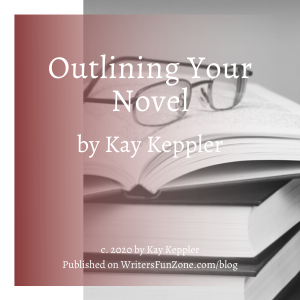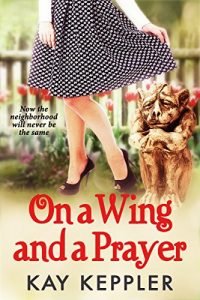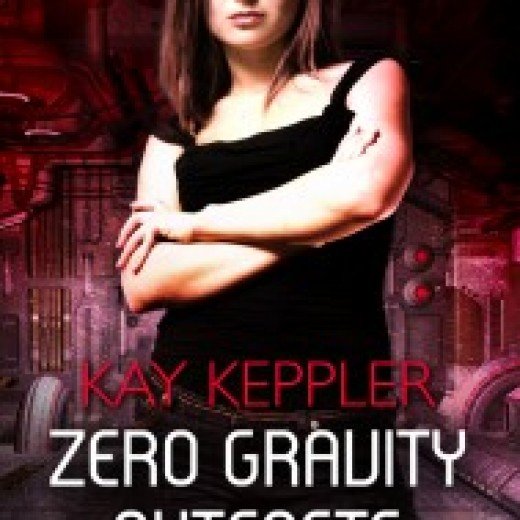Outlining Your Novel by Kay Keppler
 Let’s welcome back monthly columnist, editor, and novelist, Kay Keppler, as she shares with us “Outlining Your Novel.” Enjoy!
Let’s welcome back monthly columnist, editor, and novelist, Kay Keppler, as she shares with us “Outlining Your Novel.” Enjoy!
***
Your Outline: A
Writers often get stuck in the middle of their work when they don’t know where their story should be going. Raymond Carver once said that when he got stuck in his writing, he had a man enter the room with a gun. Alas, the sagging middle can’t always be revived with a gun. If only it were so easy!
Outlining Your Novel: To Outline, or Not
I don’t know if Carver ever wrote with an outline, but many writers don’t.
Some writers resist outlining because the technique doesn’t work for them—they can’t see ahead, or they find that an outline is too limiting, or the outlining process steals their creativity.
Other writers can’t write a book without the roadmap that tells them in what direction to head.
However, sooner or later, every writer needs to develop the big picture, the foundation on which you build the details of plot, character, and setting so that you can see that everything will work.
Don’t think of the process as that indented, Roman-numeral outline agony you did in school. Think of it as brainstorming.
Outlining Your Novel: To Start, Go Wild
Begin by writing down everything you can think of that might go into your story, even the crazy stuff you’re pretty sure won’t make it into the final draft.
Include your characters, themes, scenes, and all the what-if scenarios. Leave nothing out. Don’t hold back, and don’t put it in order.
Maybe write it in longhand, which is probably different from how you write your books.
The idea is to let go.
Don’t stress that you don’t have enough items, or you have too many, or you don’t see a plot.
Write it in paragraphs, if you want, or lists.
Have fun with it. Go nuts. It’s discovery.
When you’re done, set it aside.
See What You’ve Got
When enough time has gone by so that the fever of a new idea has cooled and you can be more objective about it, read your discovery page again.
- What’s the big picture here?
- What are your themes, if any?
- Does a motif show up?
- Does a character seem more important than you thought at first?
- What stands out?
Maybe all you want to capture is your protagonist, his/her goal and motivation, and your antagonist, his/her goal and motivation.
That sets up your conflict. And that might be enough.
Maybe that’s too much to expect.
Maybe you’re not seeing an antagonist yet.
Maybe what you see is a clown in a hot-air balloon.
Fine. Don’t judge. Include it.
Connect the Elements in Outlining Your Novel
Make a list of everything you like about the story from your brainstorming and then examine those items.
- Do the dots connect? If not, ask yourself, what if?
- What if X or Y happened?
- What’s the worst that could happen?
If the dots connect, great. You can probably just get to work. But if you see some holes, or places where the structure isn’t working, or big questions aren’t answered, spend some time thinking those issues through.
Write them down. Fill in the blanks.
Maybe you want to rest it again.
If so, rinse and repeat until you think you have the major points figured out, that you understand the characters, at least in broad strokes, and you know what your plot is and that it should work.
Eventually you’ll have a page—or maybe, like Jeffrey Deaver, 200 pages—of a broad structure that should give you a road map for your story.
Keep It Flexible When Outlining Your Novel
That doesn’t mean it can’t change as you go along. Of course, new ideas will crop up as you write. Characters and plot points will shift around. You can always adjust your brainstorming page. The idea is not to lock yourself in, but to help you move forward.
Doing even an abbreviated brainstorming page like this one can help you focus as you write so you don’t get lost in the weeds.
Knowing where you’re headed frees your imagination to take the most interesting route there. Even just a few concepts articulated in advance can save you a lot of time and heartache later.
The End Game: Optimizing Your Creativity
At some point, whether you outline extensively, early, and often (or not), your book has to make sense.
You can figure it out before you start writing, or you can do it later, after your first draft is written and you start revisions.
There’s no wrong way or right way.
You just want to find a way that optimizes your creativity and efficiency.
If you hate rigid outlining, doing a brainstorming page might change your mind about how you plan out your book.
***
Editor’s Note: If you want more tips on planning your novel, check out our resources:
- 7 Essential Keys to Planning Your Novel: Story Preparation for Pantsers — This book is great if you want the bare minimum to get you started and comes with a fun and useful Bonus Pack that includes a checklist, videos, and more!
- Plan Your Novel Like A Pro: And Have Fun Doing It — This book is great if you want extensive story planning tools to help you develop your idea seedling in a fully-fledged story outline, so you can write your story with confidence and clarity. The book comes with a Bonus workbook and a 50% off coupon to the online course.
- Plan You Novel: The self-paced course — Jump right into the course at Barany School of Fiction. This course comes with teacher support.
When you sign up for the bonuses that come with the first 2 books or you sign up for the class, you also get access to our community, Fellowship of the Pen, and the support we provide:
- Weekly writing sprints to help you focus on your writing
- Monthly Q&A calls to get live coaching and join together in community to learn from each other and support each other
***
Want to read more articles like this one Writer’s Fun Zone? Subscribe here.
***
ABOUT THE AUTHOR
 Kay Keppler is an author Zero Gravity Outcasts, Betting on Hope, Gargoyle: Three Enchanting Romance Novellas, and editor of fiction and nonfiction –Angel’s Kiss and Outsource It!
Kay Keppler is an author Zero Gravity Outcasts, Betting on Hope, Gargoyle: Three Enchanting Romance Novellas, and editor of fiction and nonfiction –Angel’s Kiss and Outsource It!
She lives in northern California. Contact her here at Writer’s Fun Zone in the comments below, or at kaykeppler@yahoo.com to ask questions, suggest topics, or if you prefer, complain.
***
More popular articles by Kay Keppler on Writer’s Fun Zone:
- Developing Your Voice
- Lift Your Story with Character Archetypes
- Revealing Backstory through Nonverbal Communication
- Make ’Em Laugh
***







Raymond Chandler was the one who said when stuck have a man with a gun enter. Not Carver. But good article,
Hi Susan,
You’re absolutely right! Thanks for correcting that.
[…] Outlining Your Novel by Kay KepplerWhether you’re a pantser or a planner, outlining your novel can be very helpful […]
Thanks for the mention!